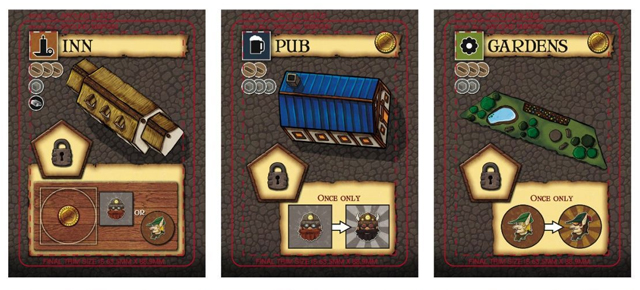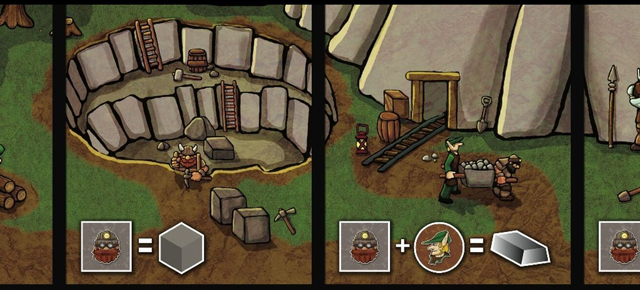
As I mentioned in my Best of 2011 edition, Jay Cormier’s and Sen-Foong Lim’s Belfort (published by Tasty Minstrel Games) is a grand mix of various traditional Eurogame mechanics. Up to five players have seven months (rounds) to carefully place workers (elves, dwarfs, and to a lesser extent gnomes), manage resources, and vie for control of the five districts of the titular city as they race to construct it before the winter arrives and the yetis attack. That may seem like a lot — and it is. Early plays of Belfort will test you like few other games, and new players are likely to be overwhelmed by the options and strategies available.
Players each start with three dwarfs, three elves, five gold coins, one of each building material (wood, stone, and metal), a hand of four building cards and a dozen building markers. In randomly-determined turn order, players place one worker at a time on one of the various planks (spaces) available; some planks cost one or two gold to use, but most of them are free. Players can also effectively pass by distributing their remaining workers among the four resource/gold-generating spaces. Once all players have passed (or otherwise run out of workers), resources and new recruits are collected, then any workers placed in the King’s Court may swap turn order with another player. Finally, each player earns income generated by constructed buildings; in rounds four through seven they then have to pay taxes based on their current score. This tax mechanic is a great “punish the leader” effect, as getting out to an early lead will cost you dearly if you aren’t prepared for the fees.

Following the general actions, each player in turn then takes as many personal actions as they wish. Personal actions include activating any workers placed on buildings or guilds to earn their benefit, building one or more cards from their hand, building a guild or part of the city wall (which have no cards and are available to all palyers), visiting “Crazy Ord’s Trading Post” to exchange materials for gold (or vice versa), or hiring one gnome to unlock abilities on constructed buildings. A final action, purchasing a new card for one coin, can be also taken but it is the last one allowed in a turn. Any structures built allow a player to place one of their building markers on the appropriate location in one of the five districts.
The ends of rounds three, five, and seven are scoring phases. Players can earn points for having majorities in elves, dwarfs, or gnomes as well as constructed buildings in each district; second-place awards are also available, and if four or five players are involved then districts offer a potential third-place award. Keep in mind that any ties earn the tied players the lesser award each (e.g., a tie for first earns everyone the second-place award) and other players are bumped down accordingly. Being able to adjust the turn order comes in especially handy during these scoring rounds, allowing you to better manipulate majorities.
A successful game of Belfort is one of careful strategy. The first three rounds are crucial, as they are the only ones without taxes. Increasing your workforce helps, but if you’re not earning income from buildings then you might find yourself short of options later on. Of course, more buildings means more potential to score as well, which is a double-edged sword in the latter half of the game. Further complicating matters are the five guilds; at the beginning of the game five tiles are randomly selected from the Basic, Resource, and Interactive piles to see which guilds will actually be present in the game. The exact mix depends on what difficulty level the players desire, but the default is one interactive and two of the other two types. The presence of certain guilds — especially the interactive ones — will dramatically affect games and keep subsequent replays fresh. Building a guild does not provide income directly, but any other player using that guild’s plank must pay you a coin (an unowned guild’s dues are paid to the bank).

While all of this mechanical gameplay is more than fine, what really sets Belfort apart from other Eurogames is its humor and theme. It doesn’t come with instructions; it comes with “Rules and Red Tape: A Gnomish Guide to Royal Construction Methods & Practices — City Planning Edition (Property of the Belfort Rules Lawyers’ Guild)”. The various districts are colorful depictions of the town, and have subtle Easter eggs hidden in the art, including a reference to Settlers of Catan and an appearance by a popular webcomic adventuring party, among others. There are lots of other extra details and commentary provided for the amusement of anyone who wishes to find it. None of this is necessary to play the game in any way, shape, or form, but the fact that it was included at all indicates how dedicated the designers were to creating this game.
Humor aside, Belfort is a solid offering for any game night, lasting from 90 to 120 minutes — although initial games might take a little longer as everyone gets used to all of the moving parts. There’s a lot of wood and high-quality cardboard in this box, and as a result Belfort retails for around $65, but that’s a small price to pay for this much quality.



















